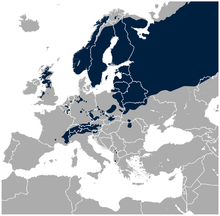Black grouse
| Black grouse | |
|---|---|
 |
|
| Male
Bird recorded in Fife, Scotland
|
|
| Scientific classification | |
| Kingdom: | Animalia |
| Phylum: | Chordata |
| Class: | Aves |
| Order: | Galliformes |
| Family: | Phasianidae |
| Subfamily: | Tetraoninae |
| Genus: | Tetrao |
| Species: | T. tetrix |
| Binomial name | |
|
Tetrao tetrix (Linnaeus, 1758) |
|
 |
|
| Black Grouse range | |
 |
|
| Distribution in Europe. | |
| Synonyms | |
|
Lyrurus tetrix L. |
|
Lyrurus tetrix L.
Lyurus tetrix
The black grouse or blackgame or blackcock (Tetrao tetrix) is a large game bird in the grouse family. It is a sedentary species, breeding across northern Eurasia in moorland and bog areas near to woodland, mostly boreal. The black grouse is closely related to the Caucasian grouse.
The female is greyish-brown and has a cackling call. She takes all responsibility for nesting and caring for the chicks, as is typical with gamebirds.
The black grouse's genome was sequenced in 2014.
The black grouse is one of the many species first described in the 10th edition of Systema Naturae in 1758 by Carl Linnaeus, and still bears its original binomial name. Both Tetrao and tetrix come from Ancient Greek words referring to some form of game bird.
The male and female are sometimes referred to by their folk names, blackcock and greyhen respectively. These names first occur in the literature with John Ray in 1674.Heathcock and Heathhen are also common names.
Black grouse is a large bird with males being around 53 centimetres (21 in) long and weighing 1,000–1,450 g (2.20–3.20 lb) and females approximately 40 cm (16 in) and weighing 750–1,110 g (1.65–2.45 lb). The cock is very distinctive, with black plumage, apart from red wattles and a white wingbar, and a lyre-shaped tail, which appears forked in flight. His song is loud, bubbling and somewhat dove-like.
Black grouse can be found across Europe (Swiss-Italian-French Alps specially) from Great Britain (but not Ireland) through Scandinavia and Estonia into Russia. In Eastern Europe they can be found in Hungary, Latvia, Lithuania, Poland, Belarus, Romania and Ukraine. There is a population in the Alps, and isolated remnants in Germany, France, Belgium and the Netherlands. It formerly occurred in Denmark, but the Danish Ornithological Society (DOF) has considered it extinct since 2001. The species disappeared from Bulgaria in the 19th century.
...
Wikipedia

